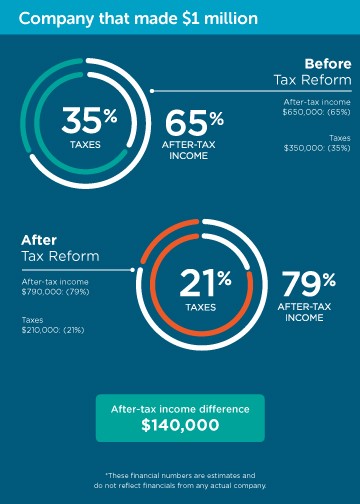
Posted on: March 16, 2018
The competition is fierce for businesses across the country: Finding and keeping top talent has become a top priority. Given the low unemployment rate and growing economy, job prospects often receive multiple offers with rich employment packages.
Prospective employees rank job salary as a top consideration when reviewing positions, but many also have high expectations for their employment experiences, including competitive and meaningful benefits, continuous training, and career path connections. Offering the right package of opportunities is a challenging task for employers, but the 2018 Tax Cuts and Jobs Act provides options they can use to improve their employment strategies. Consider four ways employers can use tax opportunities within the tax code to enhance employee experiences.
1. Capitalize on the 20 percent deduction for flow‑throughs
Under the new tax plan, sole proprietorships, partnerships, and S corporations are entitled to take a deduction equal to 20 percent of the qualified business income earned. This is for ordinary, non-investment income. The deduction is limited to 50 percent of the total W-2 wages paid by the business. It may sound confusing, but the way to capitalize on this option is to provide employee benefits that both raise the W-2 wage and provide value to employees. A few examples are fitness reimbursements, cell phone subsidies or a student loan repayment benefit, such as the BenefitEd program offered by Ameritas in partnership with Nelnet.
2. Replace excluded benefits
In 2017, nearly 76 percent of employers subsidized employee transportation and parking costs, reports the International Foundation of Employee Benefit Plans. They also covered entertainment costs for employees. Both were tax-deductible benefits for businesses, but they no longer are deductible under the new Tax Cuts and Jobs Act.
Economic analysts believe employers that view the transportation subsidy as vital to employee recruitment and retention will voluntarily pay taxes to provide this benefit. However, other businesses are exploring a range of different benefits that employees value, such as increased contributions to 401(k) plans or assistance in repaying student loans. Many new college graduates are bringing extensive debts, of at least $35,000, to their jobs. This debt load can significantly limit their family and lifestyle choices. Providing a student loan repayment benefit is an excellent way to engage employees, relieve financial stress, and enhance their employment experience.
3. Build on the pre-tax and post-tax differential
Many entry-level and younger workers enter the workforce at a lower tax bracket. This means the cost differential between pre-tax and post-tax benefits isn’t significant and employees will achieve a better return by instead providing meaningful benefits their employees will
Employers can creatively use this tax option to offer benefits that help them hire and keep great workers, such as offering an unexpected signing bonus. They also are looking to enrich job offers by providing rewards and benefits employees value, such as flexible work and vacation schedules or making extra contributions to help pay off student loans at incremental levels based on a vesting schedule or work longevity plan.
4. Support education
The 529 college savings plan is a popular benefit with many employees wanting to put money aside to pay for their child’s education. Under the Tax Cuts and Jobs Act, the 529 account fund was expanded to include savings of up to $10,000 for K-12 tuition and expenses at elementary or secondary public, private or religious schools and specific homeschool expenses.
Employers can enhance this benefit by making donations or matching employee contributions to 529 accounts. Many older employees also are using the 529 option to save for their grandchild’s college educations. Providing the 529 account benefit is another excellent recruitment and retention strategy and engages employees in their work.
Employers interested in capitalizing on new employee benefit options available under the Tax Cuts and Jobs Act should work with their financial adviser to find the best opportunities for their business.
Sources
Inc.: Final Tax Bill Impacts on Businesses
CNBC: Tax Bill Provision Helps Families Save on School Costs
New York Post: Workers Could Lose Commuter Benefits Under New Tax Plan
AOL: After Tax Cut Which Employee Perks are Best
Chicago Tribune: New Tax Law Affects 529 College Savings Plans
